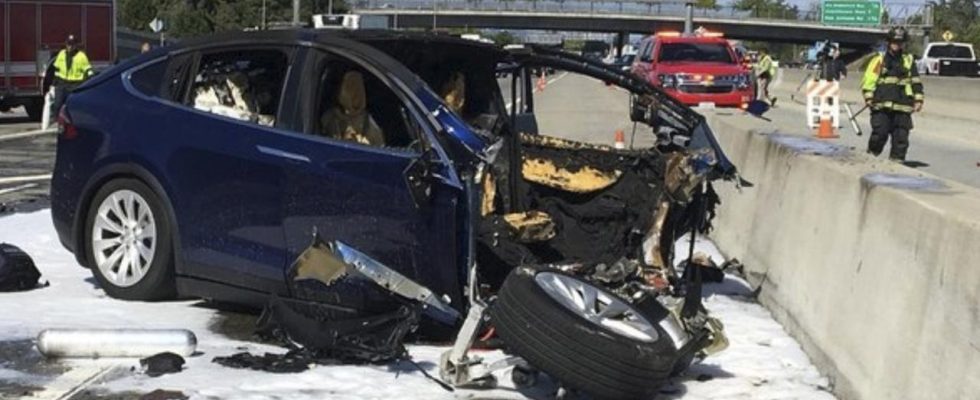analysis
Tesla averted a lawsuit over a fatal accident at the last moment. Experts have doubts about Tesla’s argument that the driver is always to blame in accidents involving Autopilot.
On March 23, Walter Huang’s Tesla vehicle crashed into a concrete barrier on a highway in Silicon Valley – with the autopilot switched on. The 38-year-old Apple employee died of his injuries in hospital shortly afterwards.
Six years later, his family has now agreed to a settlement with Tesla. At Tesla’s request, this should be kept secret at what price. One thing is certain: It was an agreement at the last moment; the trial against Tesla was supposed to start today in San José, California.
Perfect timing for Elon Musk
The agreement comes at an important time for the electric car manufacturer, as Tesla boss Elon Musk is currently heavily promoting self-driving technologies. These are the key to the economic future of the world’s most valuable car company. Just at the beginning of the week, Musk announced that he would present the long-promised robotaxi on August 8th.
There was a lot at stake for Tesla, especially since there were some indications in advance that the car company would not automatically be successful this time with its usual line of argument, according to which the driver should always be blamed for accidents involving the autopilot.
Tesla: The driver is to blame
The US company recently won two lawsuits in California, alleging that drivers had not followed instructions to remain vigilant while using the Autopilot system.
In Huang’s case, Tesla also defended itself by saying that the accident was ultimately due to the driver’s carelessness. Huang used his iPhone shortly before the fatal accident and played a video game on it.
Witness statements weigh on Tesla
Huang’s family, on the other hand, sees Tesla as being to blame because the company knowingly introduced a “faulty” function with the autopilot and raised false expectations among consumers.
Tesla employees have testified to lawyers for Huang’s family that before the 2018 accident, the car company never studied how quickly and effectively a driver could gain control of the vehicle when Autopilot steered it directly toward an obstacle.
According to another witness, it was only in 2021 – three years after the accident – that Tesla introduced a driver monitoring system that tracks the driver’s movements using cameras and alerts him if he is not concentrating on the road in front of him.
Tesla autopilot only one Lane departure warning?
But how exactly does the Tesla autopilot actually work? The Huang family’s lawyers also asked themselves that question. In July 2023, they contacted Akshay Phatak, a Tesla engineer. The The Washington Post reported on his testimony. “If there are clearly marked lane lines, the system follows the lane lines,” Phatak said under oath.
The system that Tesla advertises as “groundbreaking” is simply designed to follow the road markings. In competing cars, this is usually simply referred to as lane departure warning.
The Post further reported that Huang’s car swerved as the road markings became increasingly faint. This apparently confused the autopilot. However, he then recognized a clear marking on the left side – and drove the Tesla directly into the concrete barrier.
View of US-101 with the road markings that confused the Tesla Autopilot (Source: NTSB).
Traffic Safety Authority criticizes Tesla
An investigation by the US traffic safety authority NTSB (National Transportation Safety Board) also came to this conclusion. Tesla failed to limit the use of Autopilot in such cases, which contributed to the accident. Musk’s company admitted to the NTSB that the autopilot was only designed for roads with “clear lane lines.”
The agency also complained that the “ineffective monitoring of driver intervention” contributed to the driver’s “complacency and inattention.” The bottom line is that the NTSB concluded in its investigation that there was no clear cause of the accident.
Doubts about Musk’s promises
This accident is by no means an isolated case. The NTSB investigated at least 956 accidents in which Tesla Autopilot was said to have been used. The authorities investigated 40 cases, 23 of which resulted in death. Amid these investigations, Tesla recalled more than two million cars with Autopilot in December to install more driver alert systems through a software update.
Tesla is currently facing over a dozen Autopilot processes in the US; Eight of them involve fatal accidents that pose the risk of high fines for the car company. So it’s no wonder that Tesla feared a precedent would be set in the case of the Apple employee who died in an accident.
The numerous autopilot processes also raise doubts as to whether Elon Musk can live up to his full-bodied promises regarding autonomous driving. After all, Musk already stated in 2016 that a Tesla would be able to drive from Los Angeles to New York by the end of 2017 – without the driver having to touch the steering wheel even once.

